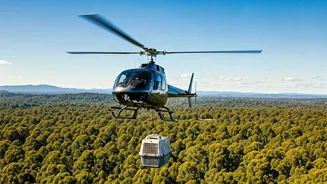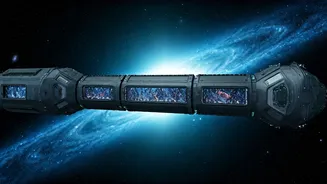A Historic Undertaking
Madhya Pradesh is gearing up to spearhead a pioneering wildlife relocation initiative, an endeavor that marks a significant milestone in India's conservation
history. The state is poised to become the first in the nation to employ helicopters for the critical task of relocating wild animals. This innovative method represents a substantial evolution in how wildlife management and conservation are approached. Helicopters offer distinct advantages when it comes to capturing and transporting animals. They allow for rapid movement across difficult terrains, potentially reducing stress on the animals during the relocation process, and enabling access to remote habitats. The initiative is not merely about moving animals, but also about the strategic deployment of conservation resources to optimize wildlife protection and population management. This first-of-its-kind project in India aims to set a precedent for future conservation endeavors nationwide and to enhance biodiversity management.
Why Helicopters Matter
The decision to use helicopters for wildlife relocation is not arbitrary; it's a strategic choice driven by operational benefits. Helicopters offer several advantages over traditional methods like ground transportation. They greatly reduce the time required to move animals between habitats, which is vital for minimizing stress and reducing the risk of mortality. Helicopter transport also allows for the relocation of animals across complex or inaccessible terrain, such as dense forests, mountainous areas, and wetlands. This facilitates the expansion of wildlife populations into new areas, enabling better genetic diversity, and reducing potential conflicts between humans and animals. Furthermore, helicopters permit precise planning and execution, giving conservationists greater control over the relocation process, and enabling the placement of animals in the most suitable new environments. The initiative can contribute to the preservation of endangered species and also promote a more balanced distribution of wildlife populations within the state.
Strategic Significance Explained
The implementation of the helicopter-led wildlife shift carries considerable strategic importance, extending far beyond the immediate task of moving animals. This initiative underscores a proactive commitment to biodiversity conservation and ecological balance. It signals a move toward advanced and effective methods, promoting environmental sustainability on a broader scale. By using this innovative strategy, Madhya Pradesh could become a model for other states, encouraging them to adopt similar approaches. The success of this project could attract international attention, potentially boosting India's reputation in global conservation efforts and inviting collaboration and investment in wildlife conservation. Moreover, a successful program might enhance ecological resilience, fostering better adaptation to environmental changes, and ensuring the long-term health of ecosystems in the region. This project is not just a technological advancement but also represents a comprehensive strategy that harmonizes conservation goals with advanced operational capabilities.
Logistical Planning and Execution
Successful wildlife relocation using helicopters involves intricate planning and flawless execution. The operation demands detailed pre-planning, including site surveys, animal health assessments, and careful selection of suitable relocation habitats. Expert teams are needed to manage the capture, transportation, and release of animals. This involves veterinary professionals to ensure the animals' health and safety throughout the process. The process also includes advanced equipment for animal handling, specialized helicopters equipped with appropriate enclosures, and thorough protocols for safety and monitoring. Close collaboration between various government agencies, conservation groups, and local communities is necessary for a coordinated effort. The effectiveness of the project is reliant on minimizing stress on the animals, maintaining rigorous biosecurity measures, and ongoing monitoring to evaluate the relocation outcomes and make necessary adjustments. The commitment to meticulous planning and execution is crucial for achieving conservation goals and guaranteeing the long-term sustainability of wildlife populations.
Impact and Future Prospects
The expected impacts of Madhya Pradesh’s helicopter-led wildlife relocation are wide-ranging. This project could greatly improve the distribution of key species and support the genetic diversity needed for their survival. It also may help reduce pressures on overpopulated areas, lessen conflicts between humans and wildlife, and strengthen the overall health of ecosystems. Looking ahead, this initiative could inspire the expansion of similar conservation approaches across India and beyond. Advances in technology and increasing expertise may result in even more effective techniques for wildlife management. The project's long-term success will likely depend on continued evaluation, adaptive management, and the support of stakeholders, including local communities, to ensure its objectives are met. The ambitious scope of this project will likely generate valuable knowledge, contributing to conservation practices worldwide and securing a sustainable future for wildlife and habitats.













